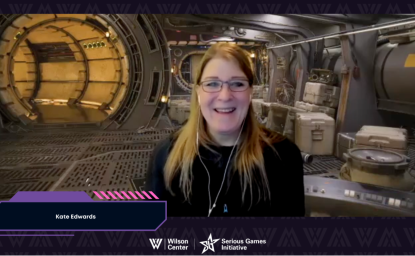Enhancing Simulations, Models and Their Impact Using Interactive Game Design and Development Practices and Technology


Executive Summary
Given the importance of models and simulations in public policy making, and the need to improve their effectiveness, the governmental and nongovernmental model and simulation building communities should be striving to explore and build on other existing model-building practices. Some of the most interesting work being done is within the interactive entertainment industry.
Every day game developers reach an audience of millions of people using increasingly state of the art hardware and programming. Not only is the game development community at the forefront of PC-based visualization, it is also a leading developer of applied artificial intelligence, overall interface design, persistent worlds, network interaction, and other building blocks needed for next-generation models and simulations.
The mission is simple - to create a better understanding of how commercial game and simulation developers, practices, and technology can be utilized by a wider field of organizations that build and apply models and simulations in the area of public policy.
This includes identifying and detailing specific steps organizations and game developers can take to blend game technology and approaches with proven model and simulation approaches to improve existing and future offerings.
Any casual observer who has seen someone interact with a computer or video game can easily understand how games can quickly captivate their audience. With their exciting visual and audio power, computer and video games take the competitive and fun nature of games to an entirely new level. Combining simulation, strategy, and the ability to play alone (if partners are not available) electronic gaming builds on basic instincts for competition, interaction, and imagination that are instinctive in so many people. By combining these elements with instructive materials, or wrapping important content in a gaming package, the hope is to utilize the strength of gaming to elevate learning and especially strategic learning among players. This has been the key goal of many nonentertainment applications of gaming technology and methods. Unlike many simulations and models, games are designed to be…
∙ Challenging ∙ Entertaining ∙ Educational ∙ Played repeatedly ∙ Multiplayer ∙ Designed so no two games are perfectly alike∙
The ability for game developers, technology, and industry practices to have a positive impact on models and simulations built for non-entertainment purposes is significant. It is already happening, despite little concerted effort by groups on either side of the aisle. The mere fact that there have already been several public-private partnerships to create games and game-like simulations on subject matter such as peacekeeping, healthcare, university management, and hazardous chemical cleanup shows the potential if partnerships could be more aggressively pursued.
Gaming is by no means a replacement for existing model and simulation building processes and practices but it has tangible advantages that ultimately could result in wider, more flexible, and more versatile products. To ignore these contributions will directly affect the ability for any simulation or model to reach its full potential.
The advantages are not just one way either, game developers could benefit greatly not only from a widening of the market for their talent but also by gaining access to a whole cadre of simulation and model building professionals and data collectors in other sectors.
By specifying the case for more involvement, and by detailing the specifics of how to create more crosspollination, it is hoped that better modeling and simulation will occur. It will not only take more specific overtures to create such a working environment, but also more successful projects and integration of skills and personnel across the public and private sectors.
Author

Science and Technology Innovation Program
The Science and Technology Innovation Program (STIP) serves as the bridge between technologists, policymakers, industry, and global stakeholders. Read more


Serious Games Initiative
The Serious Games Initiative communicates science and policy complexities through the world’s most dynamic medium: gaming. Read more

Explore More
Browse Insights & Analysis
Serious Games: The Past, Present, and Future with Kate Edwards

Serious Games: The Past, Present, and Future with Lindsay Grace

Serious Games: The Past, Present, and Future with Maria Burns Ortiz
